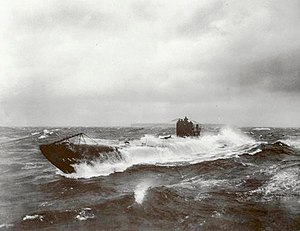 UB-148 at sea, a U-boat similar to UB-106.
| |
| History | |
|---|---|
| Name | UB-106 |
| Ordered | 6 / 8 February 1917[1] |
| Builder | Blohm & Voss, Hamburg |
| Cost | 3,714,000 German Papiermark |
| Yard number | 312 |
| Launched | 21 July 1917[2] |
| Commissioned | 7 February 1918[2] |
| Fate | Sunk 15 March 1918, later raised; surrendered 26 November 1918; used for explosive trials and dumped on beach 1921; sold for scrap 1921 |
| General characteristics [2] | |
| Class and type | Type UB III submarine |
| Displacement | |
| Length | 55.30 m (181 ft 5 in) (o/a) |
| Beam | 5.80 m (19 ft) |
| Draught | 3.70 m (12 ft 2 in) |
| Propulsion |
|
| Speed |
|
| Range |
|
| Test depth | 50 m (160 ft) |
| Complement | 3 officers, 31 men[2] |
| Armament |
|
| Service record | |
| Commanders: | |
| Operations: | No patrols |
| Victories: | None |
SM UB-106 was a German Type UB III submarine or U-boat in the German Imperial Navy (German: Kaiserliche Marine) during World War I. She was commissioned into the German Imperial Navy on 7 February 1918 as SM UB-104.[Note 1]
UB-106 was lost in an accident on 15 March 1918, but was later raised and recommissioned.[2] She was surrendered to the Allies at Harwich on 26 November 1918. After passing into British hands, UB-97 was towed to Falmouth along with five other U-boats [Note 2] for use in a series of explosive test trials by the Royal Navy in Falmouth Bay, in order to find weaknesses in their design. Following her use during 13/17 January 1921, UB-106 was dumped on Castle Beach and sold to R. Roskelly & Rodgers on 19 April 1921 for scrap (for £125), and partially salvaged over the following decades, although parts remain in situ.[5]
- ^ Rössler 1979, p. 66.
- ^ a b c d e Gröner 1991, pp. 25–30.
- ^ Helgason, Guðmundur. "WWI U-boat commanders: Hugo Thielmann". German and Austrian U-boats of World War I - Kaiserliche Marine - Uboat.net. Retrieved 9 March 2015.
- ^ Helgason, Guðmundur. "WWI U-boat commanders: Max Schmidt". German and Austrian U-boats of World War I - Kaiserliche Marine - Uboat.net. Retrieved 9 March 2015.
- ^ Dodson, Aidan; Cant, Serena (2020). Spoils of War: the fate of enemy fleets after the two World Wars. Barnsley: Seaforth. pp. 50–52, 99, 129. ISBN 978-1-5267-4198-1.
Cite error: There are <ref group=Note> tags on this page, but the references will not show without a {{reflist|group=Note}} template (see the help page).